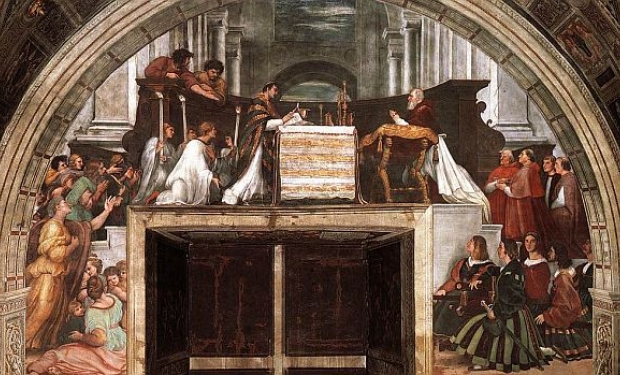The Solemnity of the Most Holy Body and Blood of Christ, popularly known as Corpus Christi, is one of the most significant celebrations in the liturgical calendar of the Catholic Church. This feast is dedicated exclusively to the adoration of the Eucharist, the sacrament in which, according to Catholic faith, the consecrated bread and wine during Holy Mass truly become the Body and Blood of Jesus Christ. The celebration highlights the real presence of Christ in the Eucharist, a central mystery of Christian faith that emphasises spiritual communion and the union of the faithful with God. Corpus Christi not only reaffirms this belief but also invites Catholics to publicly express their devotion through solemn rituals and processions.
The origins of the feast date back to the 13th century, in the city of Liège, in present-day Belgium, where the nun Juliana of Cornillon had visions that inspired her to promote a specific celebration in honour of the Eucharist. These visions drew the attention of the local bishop, Robert of Thourotte, who instituted the feast in the diocese in 1246. Later, in 1264, Pope Urban IV extended the celebration to the entire Catholic Church with the papal bull Transiturus de hoc mundo, following the Eucharistic miracle of Bolsena, in which consecrated hosts were said to have bled, reinforcing the belief in the real presence of Christ. Since then, Corpus Christi has been celebrated on the Thursday after Trinity Sunday, or in some countries transferred to the following Sunday for pastoral reasons.
The essence of Corpus Christi lies in the celebration of the Eucharist as the “sacrament of sacraments”, the source and summit of Christian life, as taught by the Second Vatican Council. During Mass, the moment of consecration is seen as the renewal of Christ’s sacrifice on the cross, though in an unbloody manner, uniting the faithful to the paschal mystery. The feast of Corpus Christi emphasises this reality, inviting Catholics to contemplate the depth of this divine gift. Moreover, the celebration reinforces the idea that the Eucharist is spiritual nourishment that sustains the journey of the faithful, promoting unity and charity within the Christian community.
One of the most striking aspects of Corpus Christi is the procession with the Blessed Sacrament, a practice that gained prominence over the centuries. During the procession, the consecrated host is placed in a monstrance and carried by the priest through the streets, often decorated with colourful carpets made of sawdust, flowers and other materials. These carpets, especially common in countries such as Brazil, Portugal, and Spain, are true works of ephemeral art, created by the faithful as an act of reverence and devotion. The procession symbolises the presence of Christ walking among His people, serving as a public testimony of faith and an opportunity for evangelisation.
In addition to its liturgical and devotional aspects, Corpus Christi also carries social and cultural significance. In many communities, the feast is a moment of togetherness, where families, neighbours, and parish groups come together to prepare the celebrations, from creating the carpets to organising community events. This collective dimension reflects the Eucharist’s call to fraternity and service, inspiring the faithful to live out Gospel values in their daily lives. Thus, the feast transcends the strictly religious sphere, influencing local culture and strengthening community bonds in various parts of the world.
Corpus Christi is an invitation to reflect on the mystery of Christ’s presence in the Eucharist and its impact on the life of Christians. It is an opportunity to renew faith, deepen spirituality, and recognise the Eucharist as a source of grace and transformation. Whether through participation in Mass, Eucharistic adoration, or the procession, the faithful are called to experience this moment with reverence and gratitude, celebrating the love of God made so intimately and tangibly present in the consecrated bread and wine.

History of the Institution of Corpus Christi
The origin of the Feast of Corpus Christi is closely linked to Saint Juliana of Liège (1193–1258), an Augustinian nun from Belgium. From a young age, Juliana demonstrated a deep devotion to the Eucharist, born from her life of prayer and study. In her mystical experiences, she reported visions in which Christ asked her to promote the institution of a special feast dedicated to honouring the Blessed Sacrament. These visions, which began in her adolescence, were interpreted by her as a divine call to foster greater reverence for the Eucharist.
In one of her most striking visions, Juliana saw a full moon with a dark spot — a symbol of the absence of a liturgical celebration dedicated exclusively to the Eucharist in the Church calendar. Convinced of her mission, she spent years sharing these experiences with local religious leaders. Despite her perseverance, she initially encountered resistance, as the creation of a new liturgical feast required approval from ecclesiastical authorities.
Around 1246, Juliana finally found support from Bishop Robert of Thourotte, Bishop of Liège. Moved by the nun’s piety and conviction, the bishop decided to institute the feast in the diocese, promoting the first official celebration of Corpus Christi. The date chosen was the Thursday after the Octave of Pentecost, symbolically linking the feast to the institution of the Eucharist at the Last Supper. This local celebration became an important milestone in the Church’s liturgical history.
One of the key supporters of the proposal was Jacques Pantaléon of Troyes, then Archdeacon of Liège. Deeply impressed by Juliana’s spirituality and the richness of the proposal, he became an important advocate for the cause, promoting Eucharistic devotion in ever-wider ecclesiastical circles. His strategic position in Liège allowed the initiative to reach more influential Church authorities.
A native of France, Jacques Pantaléon held several prominent roles in the Church hierarchy, including Patriarch of Jerusalem, before being elected Pope in 1261 under the name Urban IV. His pastoral experience and direct involvement with the movement in Liège profoundly shaped his vision of the Church and his emphasis on the centrality of the Eucharist in the life of the faithful.
It was as Pope Urban IV that, in 1264, he issued the papal bull Transiturus de hoc mundo, officially instituting the Feast of Corpus Christi for the entire Catholic Church. Inspired both by his experiences in Liège and by the Miracle of Bolsena, which had occurred the previous year and reinforced belief in the real presence of Christ in the Eucharist, Urban IV saw in the new feast a powerful opportunity to strengthen the faith of the Catholic people and to counter the Eucharistic heresies of the time. Thus, the former Jacques Pantaléon, now Pope, brought to fruition the project that had begun years earlier with the visions of Saint Juliana.
The Miracle of Bolsena
The event that catalysed the universalisation of the feast was the Miracle of Bolsena, which occurred in 1263. A Bohemian priest, tormented by doubts about the real presence of Christ in the Eucharist, was celebrating Mass in the Italian town of Bolsena. During the consecration, the host began to bleed, staining the corporal (the liturgical cloth) with blood. The miracle was interpreted as a divine confirmation of the Eucharistic doctrine, causing great commotion and reinforcing the need for a solemn celebration.
The Bull Transiturus de hoc mundo
In 1264, Pope Urban IV — none other than Jacques Pantaléon, now elevated to the papacy — issued the bull Transiturus de hoc mundo. This bull officially instituted the Feast of Corpus Christi for the entire Catholic Church, to be celebrated on the Thursday after the Octave of Pentecost. Influenced by his experience in Liège and the Miracle of Bolsena, Urban IV saw in the feast an opportunity to strengthen Catholic faith and combat Eucharistic heresies.
Expansion of the Feast
Despite the bull’s promulgation, the universal adoption of the feast was gradual. After Urban IV’s death in 1264, the celebration faced resistance in some regions due to logistical issues and the reluctance of certain dioceses to adopt new practices. However, the feast gained momentum with the support of theologians such as Saint Thomas Aquinas, who composed magnificent liturgical hymns — including the Pange Lingua and Tantum Ergo — still used today in the celebration of Corpus Christi.
Consolidation at the Council of Vienne
The Feast of Corpus Christi was definitively consolidated in the early 14th century during the Council of Vienne (1311–1312), under Pope Clement V. The council reaffirmed the obligation of the celebration throughout the Church, helping to overcome regional resistance. From that point, the feast became one of the most important in the liturgical calendar, marked by solemn processions and exposition of the Blessed Sacrament.
Legacy of Corpus Christi
Today, Corpus Christi is celebrated throughout the Catholic world, with traditions that vary according to local culture but always centred on Eucharistic adoration. The initiative of Saint Juliana, the impact of the Miracle of Bolsena, and the vision of Urban IV transformed a local devotion into a universal celebration, which continues to highlight the centrality of the Eucharist in Catholic faith. The feast is a testament to the power of individual spirituality combined with ecclesiastical authority to shape the Church’s liturgy.
Why is Corpus Christi not celebrated during Eastertide?
The celebration of Corpus Christi, marked by adoration and thanksgiving for the sacrament of the Eucharist, traditionally takes place on the Thursday after the Solemnity of the Holy Trinity, which follows Pentecost Sunday — thus, during Ordinary Time. This liturgical choice, far from arbitrary, reflects deep theological and pastoral reasons that justify the exclusion of this solemnity from Eastertide, the fifty-day period between Easter and Pentecost. It ensures that the Eucharist is celebrated with appropriate joy, solemnity, and public expression, without the limitations imposed by the penitential context of Holy Week.
First, from a theological standpoint, the primary aim of Corpus Christi is to contemplate the mystery of the Eucharist itself — the real presence of Christ and a source of grace for the faithful. During Eastertide, the Church already dedicates Holy Thursday to the commemoration of the institution of the Eucharist at the Last Supper, which marks the beginning of the Paschal Triduum. However, this moment is deeply associated with the Passion, Death, and Resurrection of Christ, giving the celebration a more introspective character tied to sacrifice. Corpus Christi, on the other hand, seeks to highlight the Eucharist as a permanent gift of Christ to the Church, emphasising adoration and thanksgiving — aspects not fully in harmony with the mournful tone of Holy Week.
In addition, pastoral reasons reinforce the choice of placing Corpus Christi in Ordinary Time. Holy Thursday, part of the Paschal Triduum, is a moment of intense spirituality and preparation for the central events of Christian faith: the Passion and Resurrection. This period is not conducive to large-scale public manifestations such as the Eucharistic processions that characterise Corpus Christi. These processions, with their joy and public witness of faith, are better suited to Ordinary Time, when the Church can celebrate the Eucharist without the liturgical and emotional constraints of Eastertide. Thus, the Church reserves a specific day for the faithful to express their Eucharistic devotion freely and solemnly, fostering vibrant community life.
Finally, placing Corpus Christi after the Solemnity of the Holy Trinity reinforces its connection with the Trinitarian mystery, since the Eucharist reflects the love of God revealed in the Trinity. This liturgical positioning allows the Church to contemplate the Eucharist as a continuation of the Paschal mystery, but in a context that favours joyful celebration and public expression of faith. Therefore, the scheduling of Corpus Christi outside of Eastertide is not a mere calendar adjustment but a deliberate choice reflecting the theological and pastoral richness of Catholic liturgy, ensuring that the Eucharist is celebrated with the prominence and joy it deserves.
